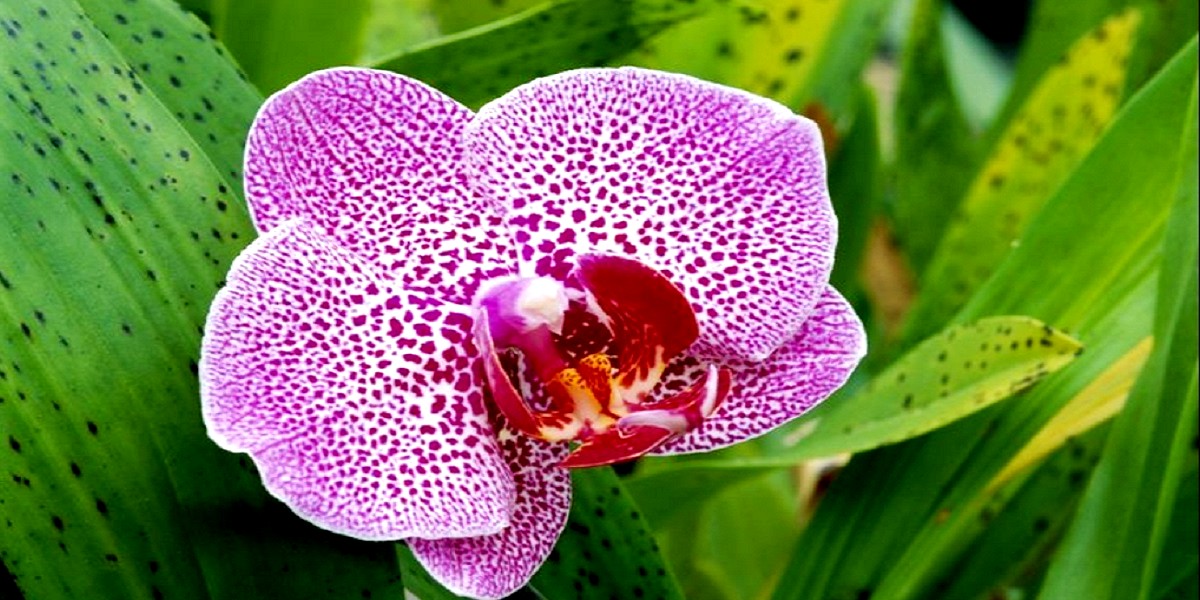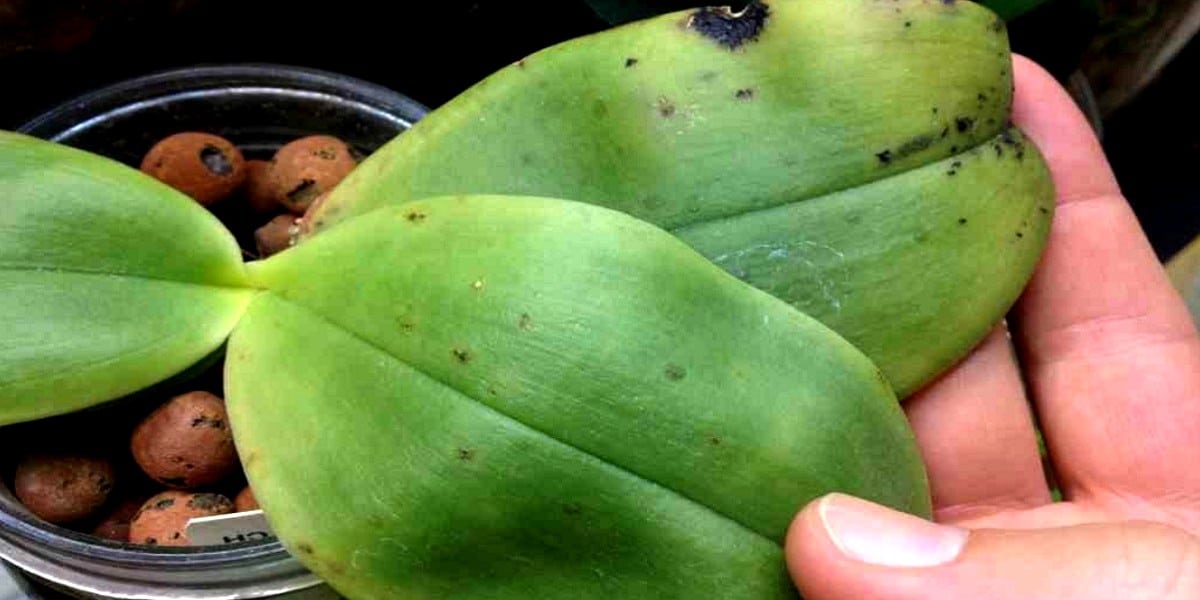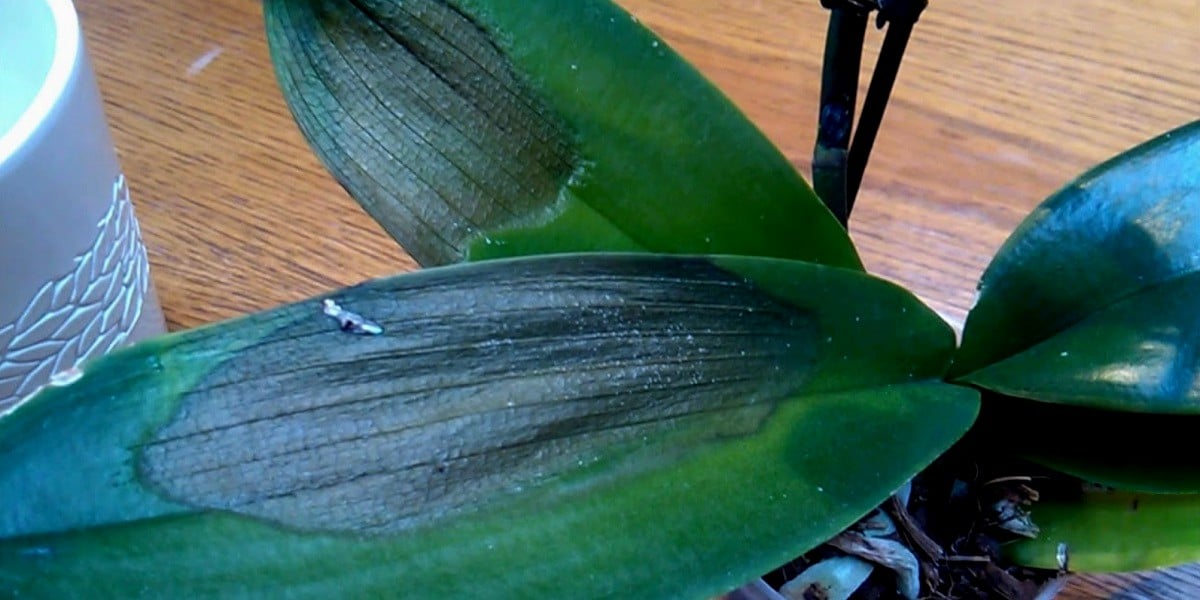Have you ever wondered how black spots on orchid leaves occur? There are several reasons for that which you have to find out. Yet, only one reason is provoked by bacteria, and you have to diagnose the disease until it is too late.
There are three main reasons for the black spots:
- The flower is damaged during the transportation. You may be surprised, but plants can get bruises similar to people. If the leaves are bruised, there will be brown spots that can last for a month;
- The flower stands under direct sunlight, which it does not need. You have to provide your orchid with enough sun, but not more. The only type of orchids that like sunlight is called Vandas;
- Bacteria got inside the plant and spread around its leaves.
You can easily solve the problems caused by the first two reasons. The third one, however, is trickier. The fungal infection black spots on orchid leaves can be prevented and even cured if you put in lots of effort. Besides, you have to know how to identify it and how to deal with it.
About Black Spots on Orchids
If you notice dark or black spots on the leaves of your favorite orchids, you need to act immediately. You have to find out the reason for these spots’ appearance and find the appropriate solution. If the plant was not damaged during the recent transportation and does not stand under the direct light, the problem may be caused by infection.

The reason for the orchid leaves turning black may be the Acidovorax or Pseudomonas bacteria. This is a bacterial infection also known as Bacterial Brown Spot. The first spots may be dark brown and small. They can be waterlogged and provide liquid when squeezed. Once the disease spreads, these spots become darker and multiply.
The disease is widely mistaken with the problem of overwatering since roots can’t absorb the water as fast as leaves eliminate the water. It creates blisters on the orchid’s leaves, and they turn black as a result. Overwatering is an entirely different problem, which you can’t ignore as well. You will notice that the soil is always wet, and the white fungus appears on it.
Meanwhile, bacterial brown spot disease starts with the greener dots on the leaves that will fade into yellow and then black. Black is the last stage of the disease. The blister falls down into the leaf. The disease becomes easy to recognize.
Different types of black spots:
- Big black spots that can spread on 1/3 of the leaf. These plant diseases are known as Black Rot. The disease starts from the root and spreads to the leaves;
- Spots that appear on the roots and pseudobulbs are not signs of Bacterial Brown Spot;
- The tips of leaves turn brown and later black can be the sign of Glomerella, Anthracnose, or Colletotrichum fungal disease;
- The smudges are elongated and cover a small amount of territory when the leaves have Guignardia Leaf Spot disease. They look like parallel veins on the leaf. With time they will turn into thin lines;
- Among all orchid plant diseases, Phyllosticta Leaf Spot is similar to the Bacterial Brown Spot. It starts as the small circles of yellow color on the leaves that later turn into black ones. The major difference is that it is a fungus, not a bacteria. The fungus has evolved and can now reproduce. The spores can be found in the middle of black spots.
Types of the most vulnerable orchids to the black spots
Not all orchids can get infected by black spot diseases. Some of them have strong immune systems to specific bacteria or fungus. There is a direct classification of flowers you have to keep an eye on. The most fragile orchids are:
- Phalaenopsis. Bacterial brown spots frequently appear on these orchids. The disease spreads fast and can easily get to the flowers. Without treatment, this plant will not survive. There is a limited amount of time left once the orchid is infected. You have up to 3 weeks to cure the plant or it will die. The whole disease cycle is extra speedy. If you see the black spots on the leaves, you have to act immediately to save the flower;
- Cattleyas. While the disease will not kill this type of orchid, it can significantly damage it. You will notice the yellow and light green dots on the leaves. Usually, the bacteria attack only those leaves that are old and had wounds before. They don’t progress significantly on the plant. If you have removed the petal from the flower, the disease may reappear there later.
The major causes of the disease
All bacteria prefer humid air to anything else. They quickly increase numbers in high temperatures. So, if you have an indoor plant, you have to avoid putting it into direct sunlight in a room with no air circulation. If your orchid lives outside, you have to hide it or create a shadow during the summer period, when the temperatures are too high. If you live in an area of high humidity, you need to place your orchid in a specific greenhouse, or it will not survive.
The bacteria Acidrovax’s transmission happens quickly and via the water. So, you have to know that you can’t share the same water among different plants. The best way to take disease under control is to use different bottles for each of your plants. While it is simple for houseplants, you will need separate buckets with water or just a good old-fashioned water hose for outdoor plants.

The disease spreads even if you mist the water from one bottle that is contaminated. Once the bottle touches leaves, bacteria travel around. Apart from that, you may spread numerous viruses this way. So, don’t press the bottle to the leaves, stem, or roots.
Symptoms. How to Identify Disease
You have to look for the symptoms each time you water your orchid. It can be a daily routine that will later save your plant from disease. The knowledge of disease specifics will help you to find the right treatment. If you are not sure about the diagnosis, you can always double-check it with the app. All you need to do is to upload the photo and find symptoms that match. The smart AI inside the app helps you to identify the problem.
Pay attention to the next symptoms the plant reveals:
- Black spots on the green leaves;
- The spots have a round shape;
- Black spots increase with time;
- The leaf with black spots loses its color. It turns yellow and later brown;
- The less resistant to the disease orchids begin to lose petals and leaves;
- The lesions will exude the water once it is pressured and is soft;
- The rot may kill orchids of a specific type.
Methods of Prevention and Treatment
The care for orchids starts with preventive measures you can easily provide at home. They don’t need any specific knowledge or extra preparations. Yet, preventing the disease is way simpler than treating it.
Preventive measures:
- You need to plant your orchids only in sterilized pots if they were previously used for other flowers;
- For outdoor orchids, you have to make sure that they are 3-4 feet above the earth, so there would not be any water splashes with disease;
- If you want to keep the plants healthy, no matter whether they grow inside or outside, don’t spray the water on the leaves. They mustn’t remain wet for a long period of time. If you have sprinkles outside, you have to turn them on when the sun rises, so it can dry the leaves till the midday;
- Another major condition to keep the orchids full of life is providing air circulation. To do this, you have to need to plant the orchids a distance from each other. Keep in mind that the leaves will grow significantly and may reach other plants nearby;
- The best way to save other plants from the diseased ones is to immediately isolate them. Healthy plants can’t even be watered from the same bottle as ill orchids;
- You can always use high calcium fertilizer as the natural treatment for your orchids. It will nourish the flower with all the elements it needs. Apart from that, the right fertilizer will boost the immune system of the orchid and make it less vulnerable to bacteria and fungi.
How to cure orchid with black spots
There are several ways to treat the orchid that is already ill. Once bacteria get to the flower, you have to act. The first thing you have to do is to identify the disease. If these are the black spots transmitted by bacteria on your plant, you have two different types of remedies.
Chemical:
- You may start by using the hydrogen peroxide of 3 percent. Pour the cotton swab into the remedy and touch all the spots that were infected. They have different colors and are simple to recognize. You may even try to swipe the leaf’s upper side. However, you can’t use peroxide on the underside. The main reason is that there are pores that consume oxygen and provide back carbon dioxide underneath the leaf;
- You may order bactericide at the store. It does not have to be a specific store. You can go to the nursery near the house. The most popular is Physan 20. You may find numerous solutions on Amazon or other online stores. Before you buy any bactericides, make sure that there are reviews from the clients. Pay attention to the results of the treatment. Once you bought it, follow instructions from the developer;
- Use the Truban or Terrazole fungicides for drenching. If the plant is just in the early stages of the disease, you can easily cure it by using these fungicides. Drenches of these two products are highly recommended by gardeners. Yet, you can use them only when the plant is not covered entirely in black spots, look highly fragile, and leaves are already yellow. In this case, you can try Subdue or Aliette.
Non-chemical or natural remedy:
- Cinnamon is the best non-chemical solution. It is considered a natural fungicide. Apart from that, it smells great. Create the mixture with the water and cinnamon powder you usually use in baking. The mixture must be paste-like. Once you mix everything, use a simple spoon or the cotton swab to spread it onto the leaves. After you finish with one orchid, sterilize or change all the tools to apply the paste to other plants.

Cut the leaves
You can’t save the whole plant once the disease begins to progress. If there are too many spots on each leaf and you see more appear every day, you can’t hesitate. Keep in mind that by saving one leaf, you are putting in danger the life of the whole plant. Consider it the best way to provide the right air circulation to the flower and allow the new leaves to grow.
You can try to save all the leaves using the cinnamon mixture described above, but only if the black spots have not yet reached the crown of the orchid. To cut the leaves, you need to use sterilized scissors. Once you sliced the ill leaf, you have to sterilize the scissors again before getting to another leaf. You can also apply the mixture of cinnamon and water to the cut. Apart from that, you can sterilize the wound with hydrogen peroxide. Keep in mind that too much of the remedy can harm the plant. It can burn healthy tissue. Don’t overuse it. You don’t have to cut all the leaves if black spots are concentrated on the tip of the leaf, for example. You can easily start by cutting only the area with black spots.
If one of your orchids is covered with black spots, check all other flowers nearby. Separate them one from another. You can’t risk losing the flowers. Keep in mind that these bacteria spread in water as well. You have to cut the leaves that touch the plants that grow near if you can’t replant them immediately.
Free Your Orchids from Black Spots
Experienced gardeners deal with black spots on their flowers from time to time. They are already familiar with the disease and prefer to use preventive measures in advance over fighting the disease that spreads in a blink of an eye. This article will be helpful to anyone who wants to understand the disease, find out more information about it, learn how to identify it, and separate it from similar illnesses.
If you have doubts about your diagnosis, you can check out the specific app that allows gardeners to guess the illness by photo. After you understand which problem you are dealing with, follow the recommendations about the treatment. You can pick the most suitable solution for you. All the remedies we discuss here have already been checked by millions of other users. Based on the type of orchid, its age, and infestation, and whether it grows indoors or outdoors, you can pick something you need.
Leave a Reply
You must be logged in to post a comment.